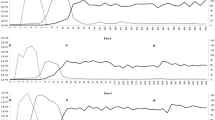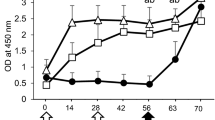Summary
EHV-1 was inoculated into specific pathogen-free (SPF) foals in order to study uncomplicated primary responses. Infection resulted in a strong serological response recognizing EHV-1-specific antigens; this contrasts with a previous publication where a weak response was recorded in SPF animals. Antibodies to EHV-1 were readily detected by four techniques (virus neutralization, complement fixation, Western blots and immune precipitation), yet there was comparatively little cross-reaction to EHV-4 target antigen. Re-in-oculation with the same virus strain stimulated antibodies to EHV-1 but no additional antigens were recognized and antibodies cross-reacting with EHV-4 antigens were not enhanced. Having characterized the uncomplicated primary response to EHV-1 in SPF foals, further animals were exposed to either EHV-4 or a thymidine kinase-deficient mutant of EHV-1 prior to challenge with w/t EHV-1 to investigate how these infections might modulate the immune responses to EHV-1 or 4. Primary inoculation with EHV-4 or with a thymidine kinase-deficient mutant of EHV-1 produced productive infections as evidenced by virus shedding and pyrexia. In both these cases, however, in contrast to that with w/t EHV-1, the serological response was very weak. Re-infection of foals primed with either EHV-4 or TK-deficient EHV-1 with w/t EHV-1 resulted in a strong response to EHV-1 antigens detected by all four methods. In addition, in the foals given a primary inoculation with EHV-4, superinfection with EHV-1 resulted in a strong cross-reactive response to EHV-4 target antigens. The relevance of these observations to the interpretation of previously reported serological responses to EHVs in SPF and naturally reared animals is discussed.
Similar content being viewed by others
References
Allen GP, Bryans JT (1986) Molecular epizootiology, pathogenesis, and prophylaxis of equine herpesvirus-1 infections. Prog Vet Microbiol Immunol 2: 78–144
Allen GP, Coogle LD, Ostlund EN, Yeargan MR (1992) Molecular dissection of two major equine herpesvirus-1 glycoprotein antigens (gB and gC) that elicit humoral immune responses in the horse. In: Plowright W, Rossdale PD, Wade JF (eds) Proceedings of the 6th International Conference on Equine Infectious Diseases. R & W Publications, Newmarket, pp 181–193
Allen GP, Yeargan MR (1987) Use of lambda gt 11 and monoclonal antibodies to map the genes for the six major glycoproteins of equine herpesvirus-1. J Virol 61: 2454–2461
Allen GP, Yeargan MR, Coogle LD (1988) Equid herpesvirus-1 glycoprotein 13 (gp 13): epitope analysis, gene structure, and expression inE. coli. In: Powell DG (ed) Proceedings of the Vth International Conference on Equine Infectious Diseases. University of Kentucky Press, Lexington, pp 103–110
Awan AR, Chong Y-C, Field HJ (1990) The pathogenesis of equine herpesvirus type 1 in the mouse: a new model for studying host responses to infection. J Gen Virol 71: 1131–1140
Billingsly PM (1985) The effect of an experimental thymidine kinase-negative bovine herpesvirus-1 vaccine on virus shedding, antibody response, and latency in cattle. MSc thesis, Texas A & M University
Browning GF, Bulach DM, Ficorilli N, Roy EA, Thorp BA, Studdert MJ (1988) Latency of equine herpesvirus-4 (equine rhinopneumonitis virus). Vet Rec 123: 518–519
Bryans JT, Allen GP (1989) Herpesvirus disease of the horse. In: Wittman G (ed) Herpesvirus diseases of cattle, horse, and pig. Kluwer Academic Publisher, Boston, pp 176–229
Burki F, Rossmanith W, Nowotny N, Pallan C, Mostl K, Lussy H (1990) Viraemia and abortions are not prevented by two commercial equine herpesvirus-1 vaccines after experimental challenge of horses. Vet Q 12: 80–86
Burrows R, Goodridge D (1984) Studies of persistent and latent equine herpesvirus-1 and equine herpesvirus-3 infections in the Pirbright pony herd. In: Wittman G (ed) Latent herpesvirus infections in veterinary medicine. Nijhoff, Boston, pp 307–319
Burrows R, Goodridge D, Denyer MS (1984) Trials of an inactivated equid herpesvirus-1 vaccine: challenge with a subtype-1 virus. Vet Rec 114: 369–374
Chong Y-C, Duffus WPH, Field HJ, Gray DA, Awan AR, O'Brien MA, Lunn DP (1991) The raising of equine colostrum-deprived foals: maintenance and assessment of specific pathogen (EHV-1/4) free status. Equine Vet J 23: 111–115
Cornick J, Martens J, Martens R, Crandell R, McConnell S, Kit S (1990) Safety and efficacy of a thymidine kinase negative equine herpesvirus-1 vaccine in young horses. Canadian J Vet Med 54: 260–266
Corrochano LM, de la Fuente R, Madueno F, Field HJ (1993) Molecular characterization of two thymidine kinase-defective mutants of equine herpesvirus-1 (EHV-1). Gene (in press)
Crabb BS, Studdert MJ (1990) Comparative studies of the proteins of equine herpesviruses 4 and 1 and asinine herpesvirus-3: antibody response of the natural host. J Gen Virol 71: 2033–2041
Crabb BS, Allen GP, Studdert MJ (1991) Characterization of the major glycoproteins of equine herpesviruses 4 and 1 and asinine herpesvirus-3 using monoclonal antibodies. J Gen Virol 72: 2075–2082
Edington N, Bridges CG, Huckle A (1985) Experimental reactivation of equid herpesvirus-1 (EHV-1) following the administration of corticosteroids. Equine Vet J 17: 369–372
Edington N, Bridges CG (1990) One-way protection between equid herpesvirus-1 and 4 in vivo. Res Vet Sci 48: 235–239
Erasmus BJ (1966) The activation of herpesvirus infections of the respiratory tract in horses by immunization against horse sickness. In: Bryans JT (ed) Proceedings of the 1st International Conference on Equine Infectious Diseases. Grayson Foundation, Lexington, pp 117–121
Fitzpatrick DR, Studdert MJ (1984) Immunologic relationships between equine herpesvirus type 1 (equine abortion virus) and type 4 (equine rhinopneumonitis virus). Am J Vet Res 45: 1947–1952
de la Fuente R, Awan AR, Field HJ (1992) The acyclic nucleoside analogue penciclovir is a potent inhibitor of equine herpesvirus type 1 (EHV-1) in tissue culture and in a murine model. Antiviral Res 18: 77–89
Gibson JS, Slater JD, Awan AR, Field HJ (1992) Pathogenesis of equine herpesvirus-1 in specific pathogen-free foals: primary and secondary infections and reactivation. Arch Virol 123: 351–366
Gibson JS, O'Neill T, Thackray A, Hannant D, Field HJ (1993) Serological responses of specific pathogen-free foals to equine herpesvirus-1: primary and secondary infection, and reactivation. Vet Microbiol (in press)
Kit S, Kit M, Pirtle EC (1985) Attenuated properties of thymidine kinase-negative deletion mutants of pseudorabies virus. Am J Vet Res 46: 1359–1367
Kit S, Kit M, McConnell S (1986) Intramuscular and intravaginal vaccination of pregnant cows with thymidine kinase-negative temperature resistant infectious bovine rhinotracheitis virus (bovine herpesvirus-1). Vaccine 4: 55–61
Laemmli UK (1970) Cleavage of structural proteins during the assembly of the head of bacteriophage T 4. Nature 227: 680–683
Slater JD, Gibson JS, Field HJ (1993) Pathogenicity of thymidine kinase-deficient mutant of equine herpesvirus-1 in mice and specific pathogen-free foals. J Gen Virol (in press)
Stokes A, Corteyn AH, Murray PK (1991) Clinical signs and humoral response in horses following equine herpesvirus type 1 infection and their susceptibility to equine herpesvirus type 4 challenge. Res Vet Sci 51: 141–148
Thomson GR, Mumford JA, Campbell J, Griffiths L, Clapham P (1976) Serological detection of equid herpesvirus-1 infections of the respiratory tract. Equine Vet J 8: 58–65
Turtinen LW, Allen GP (1982) Identification of the envelope surface glycoproteins of equine herpesvirus type 1. J Gen Virol 63: 481–485
Yeargan MR, Allen GP, Bryans JT (1985) Rapid subtyping of equine herpesvirus-1 with monoclonal antibodies. J Clin Microbiol 21: 694–697
Author information
Authors and Affiliations
Rights and permissions
About this article
Cite this article
Tewari, D., Gibson, J.S., Slater, J.D. et al. Modulation of the serological response of specific pathogen-free (EHV-free) foals to EHV-1 by previous infection with EHV-4 or a TK-deletion mutant of EHV-1. Archives of Virology 132, 101–120 (1993). https://doi.org/10.1007/BF01309846
Received:
Accepted:
Issue Date:
DOI: https://doi.org/10.1007/BF01309846




